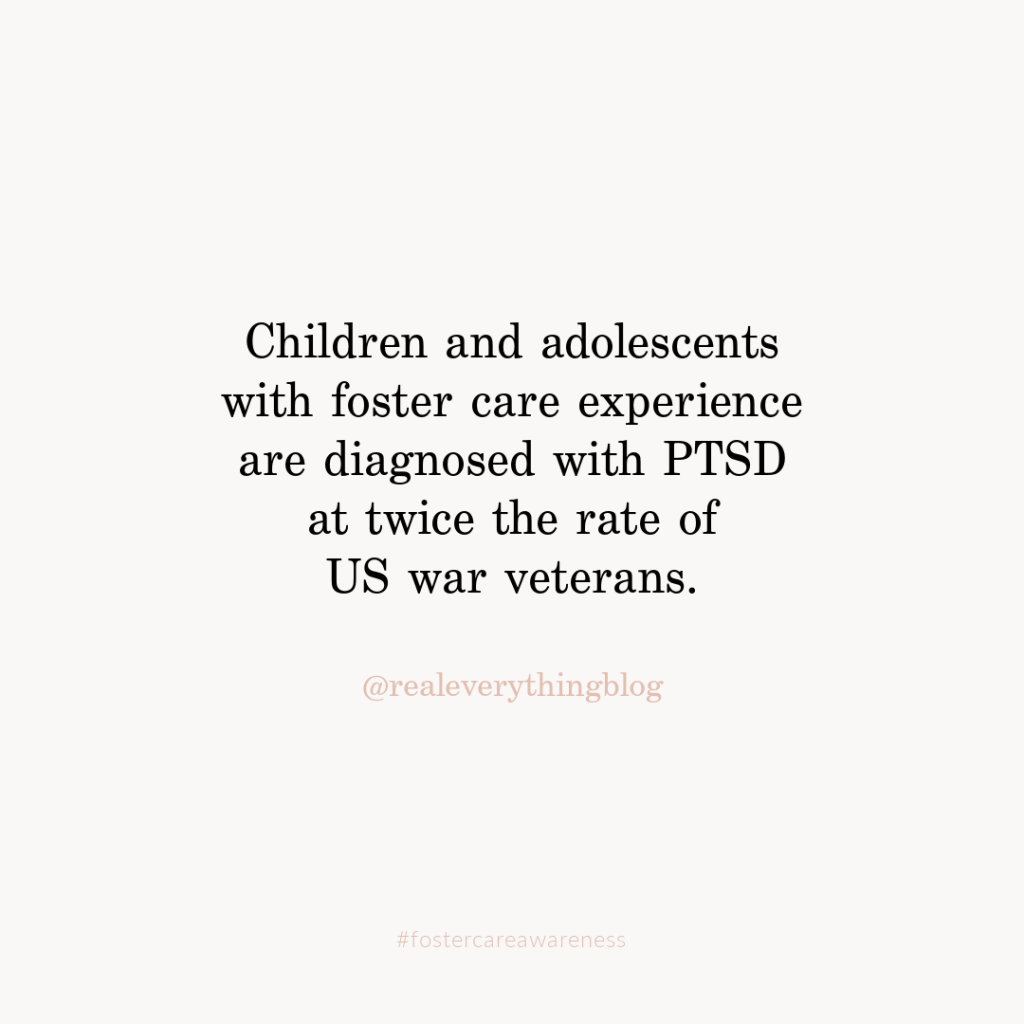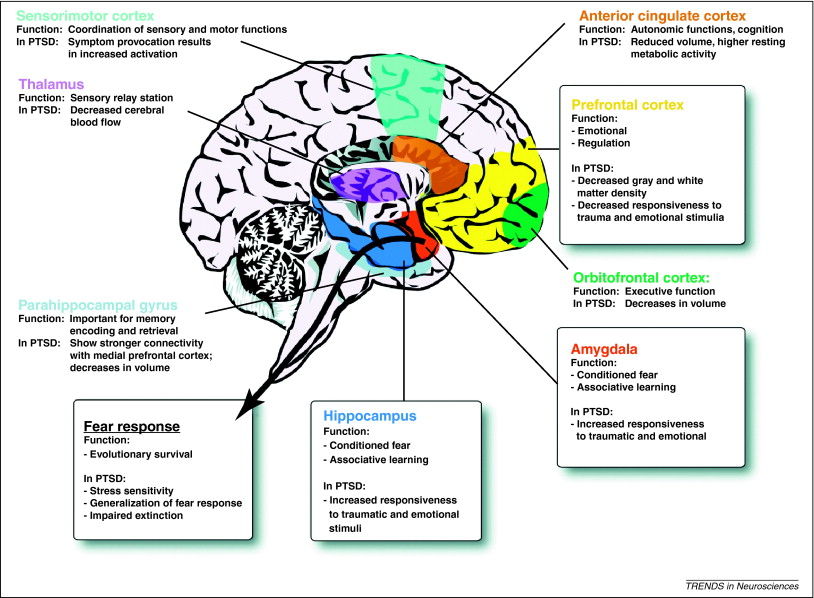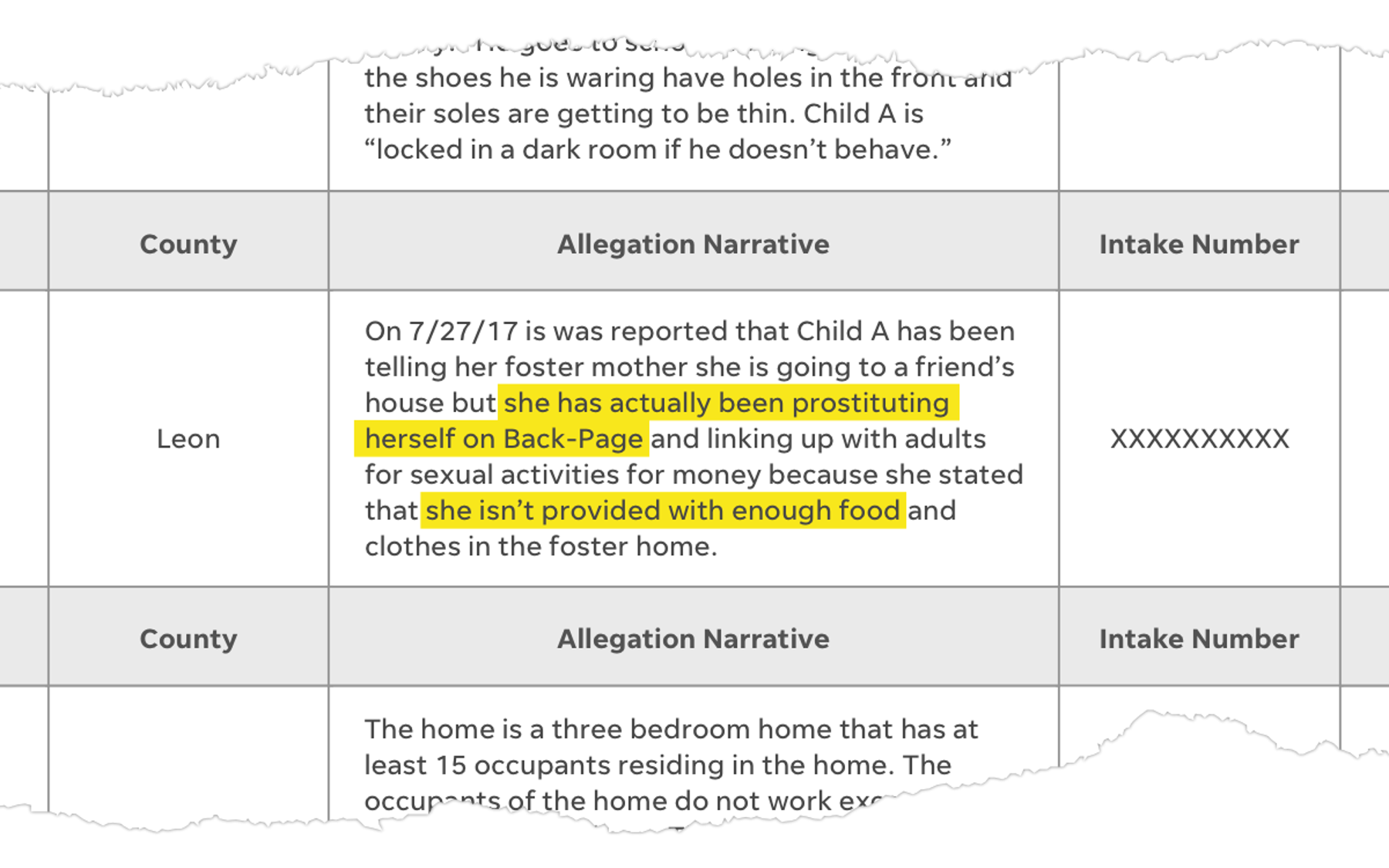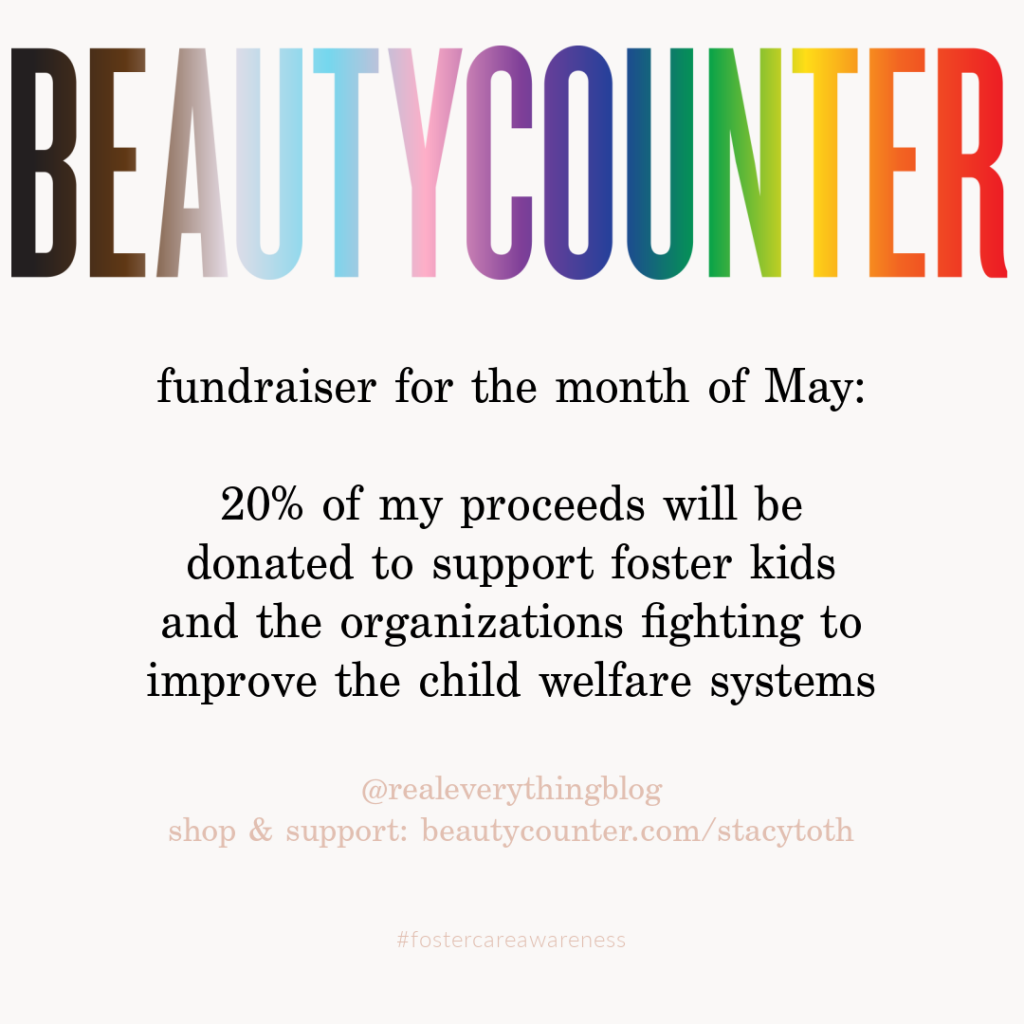While our blog has always been more than food, lately we are tackling some bigger topics here and in social media. I remember so clearly when somebody said, “how can you be worried about health from non-toxic living if your life is in danger and you aren’t safe and stable.” Truly, I don’t know why that hadn’t hit me before.
I was already a foster mom, and passionate about protecting the vulnerable – which includes the health and safety of everyone. After all, it’s why I aligned with Beautycounter’s mission so wholeheartedly. Which is why in May 2021 – Foster Care Awareness and Mental Health Awareness month, I am sharing what I’ve learned and how you can help. Plus, I’m hosting a fundraiser!
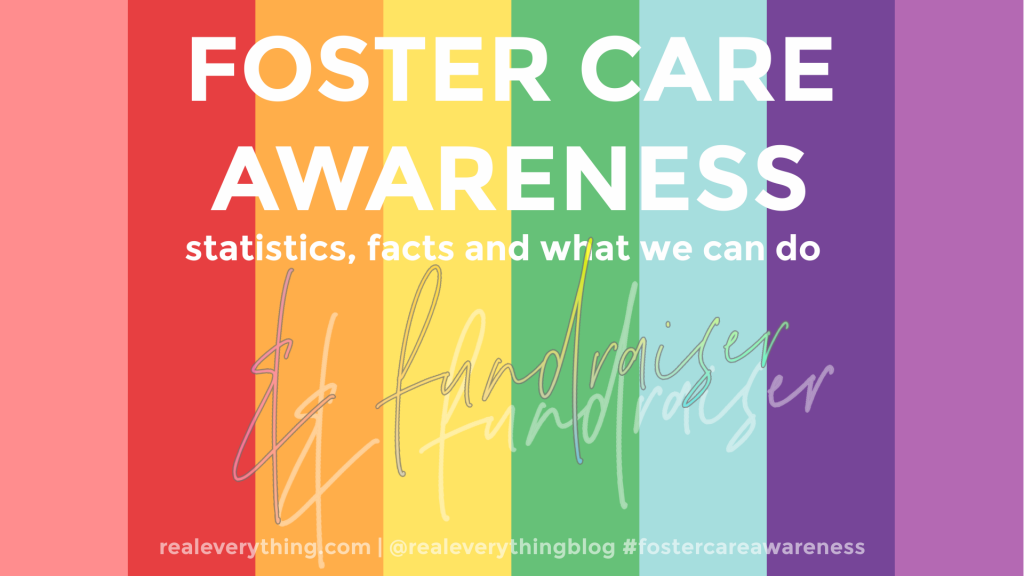
You Know Someone Impacted
Let’s bust some of the myths and miseducation out there. I think for many, myself included before becoming a foster parent, it felt mythical. Anything I “knew” was based off of assumptions or hearsay. We will definitely help curb a lot of that here today, but you likely already know someone impacted by foster care. It intends to help, doesn’t mean anyone involved is “bad”, and potentially changes lives.
Here’s a list of people you know who experienced interaction with foster care:
- Eddie Murphy
- Colin Kaepernick
- Steve Jobs
- John Lennon
- Marilyn Monroe
- James Dean
- Willie Nelson
- Ice T
- Louis Armstrong
- Cher
- Alonzo Mourning [source]
Foster Care Awareness
Reunification
The goal is reunification: studies show children do best when with family, if possible. There are always “goals” written by the state, which both the biological and foster parents need to strive towards. The length and time kids spend in foster care varies, but the goal is no longer than 18 months. My experience has been that the state goes above and beyond in attempting to reunify kiddo with family, giving support services to the biological parents.
There are countless misconceptions about foster care, one is that foster care is a punishment. It is not! Foster care is a support system to help families when they can not provide a safe environment for their children. People fall on hard times, many families don’t have strong support systems. So it is important to remember that foster care is here to allow people the time to gain the resources and skills to better support their children. [source]
These are two great articles with more information about that:
Different types of foster families:
- Many foster families go through the state, directly – actually have a friend who just adopted her foster daughter this way
- Through Agencies, which provide administrative and emotional support to foster families
- Therapeutic Foster Care, through an agency – which is what we do. Supporting foster children and teenagers who are working to overcome past trauma or abuse, or are struggling with behavioral or medical challenges. We went through extensive training to be licensed – not just as foster parents but therapeutic foster resource family (approved to both foster and foster to adopt in our state) with comprehensive ongoing support.
- Respite
Note: as a foster parent you undergo not just training but investigation. From extensive background checks to validating your financial independence – few people could surmount these obstacles to “just get foster kids for the money.” Though there are certainly people who do not have the emotional maturity to be nurturing traumatized kids, that’s a whole other topic. And really, the system is short of willing foster parents, so being picky is not a luxury they have.
On average, children and youth are in an out-of-home placement for 1 to 2 years before exiting care [source]
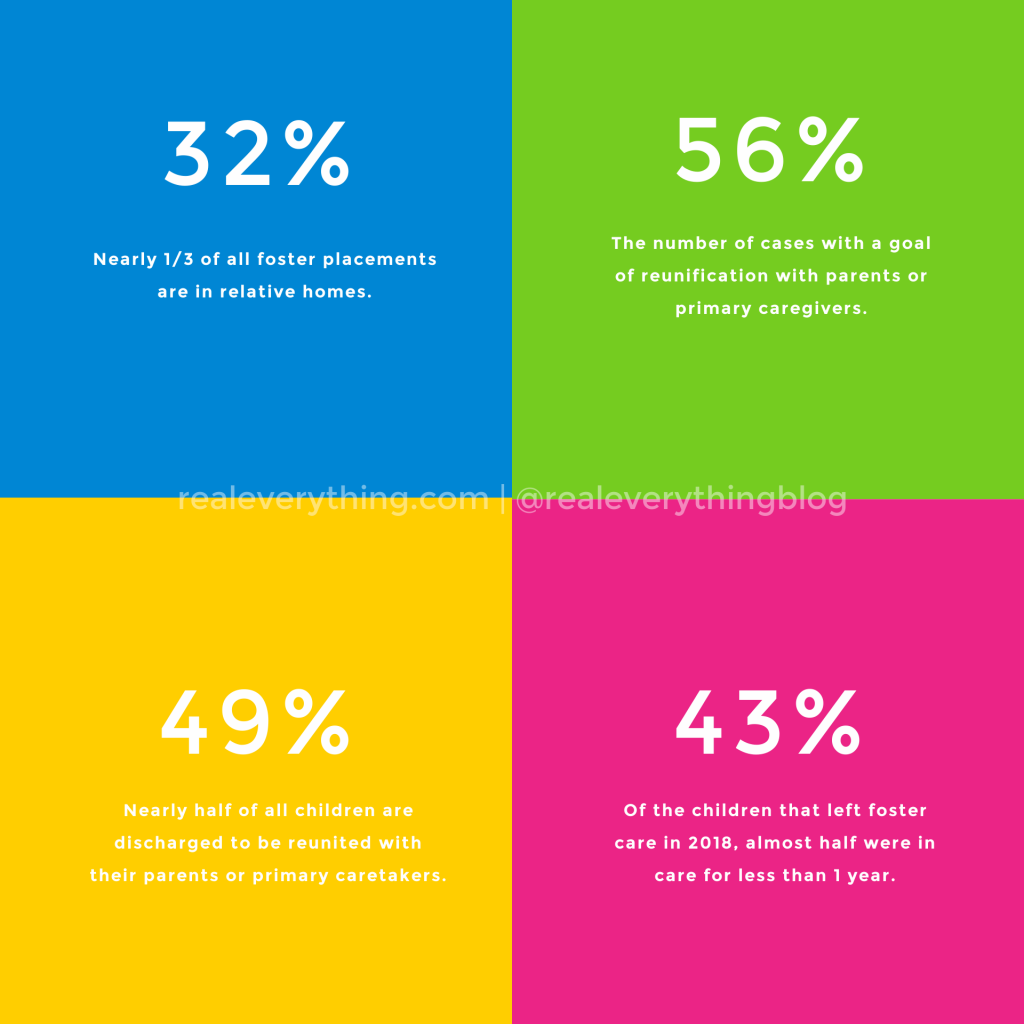
Statistics
Despite child welfare’s efforts to prevent the removal of children from their parents, the number of children in foster care has been increasing. Currently, we are at an all time high and the demand for foster parents is far higher than the supply. Adverse Childhood Experiences are rising. Factors like parental opioid addiction are forcing more children to be removed from their homes. The number of cases of children entering the foster care system due to parental drug use has more than doubled since 2000 – from around 15% in 2000 to 36% in 2017. [source]
As of September 30, 2018:
- There were an estimated 437,283 children in foster care. For perspective, every 2 minutes a child enters foster care.
- Nearly one-third of these children (32 percent) were in relative homes. Nearly half (46 percent) were in nonrelative foster family homes.
- About half (56 percent) had a case goal of reunification with their parents or primary caretakers.
- About half (49 percent) of the children who left foster care in FY 2018 reunited with their parents or primary caretakers.
- Close to half of the children (43 percent) who left foster care in FY 2018 stayed in care for less than 1 year.
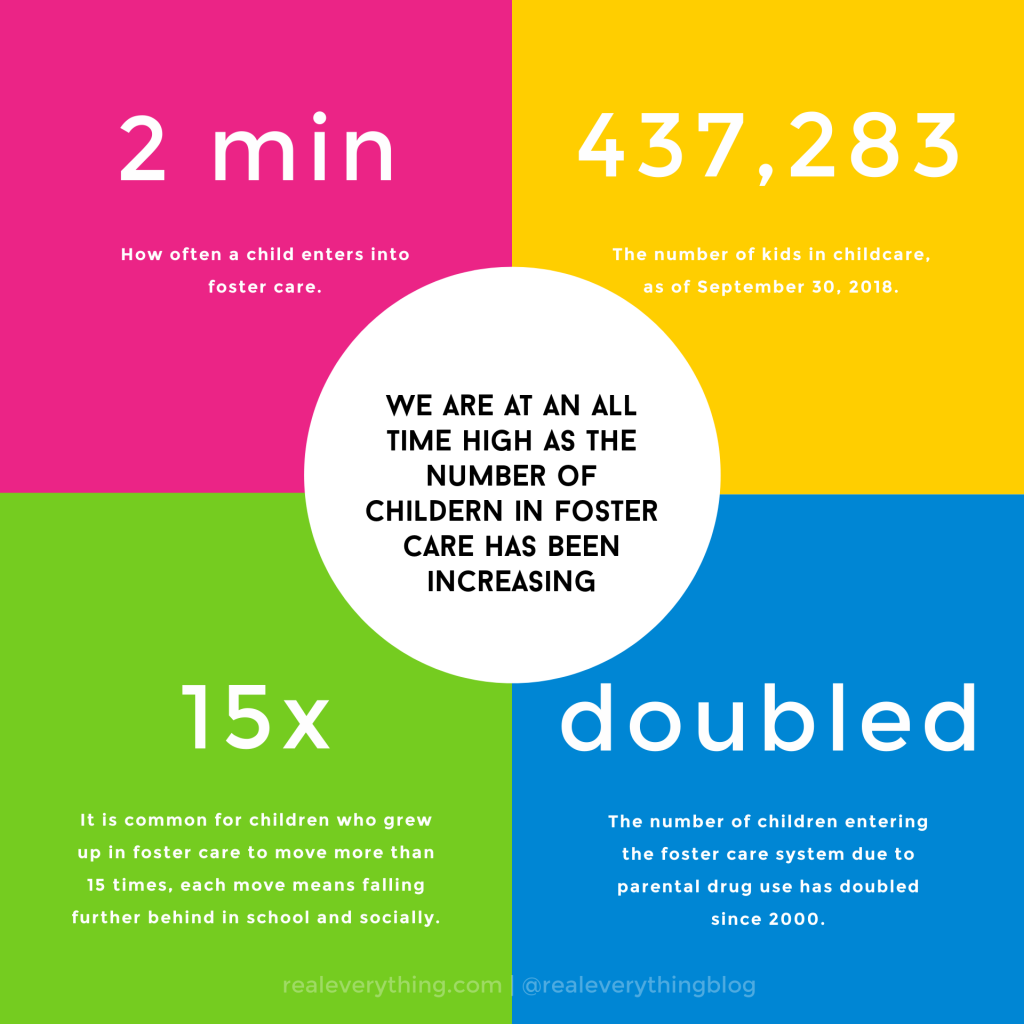
The remaining children found themselves:
- 46 percent in non-relative foster family homes
- 32 percent in relative foster family homes
- 6 percent in institutions
- 5 percent on trial home visits (State retains supervision of a child)
- 4 percent in group homes
- 4 percent in pre-adoptive homes
- 2 percent in supervised independent living
- 1 percent ran away (over 4k kids)
Outcomes include:
- 49 percent reunited with parent(s) or primary caretaker(s).*
- 25 percent adopted.
- 11 percent went to live with a guardian.
- 7 percent emancipated.**
- 7 percent went to live with another relative
- 1 percent had other outcomes.
*note: this includes kids who are returned but then later re-enter, that statistic is different
** these children were failed by the system and are now on their own, which does not have good outcome statistics
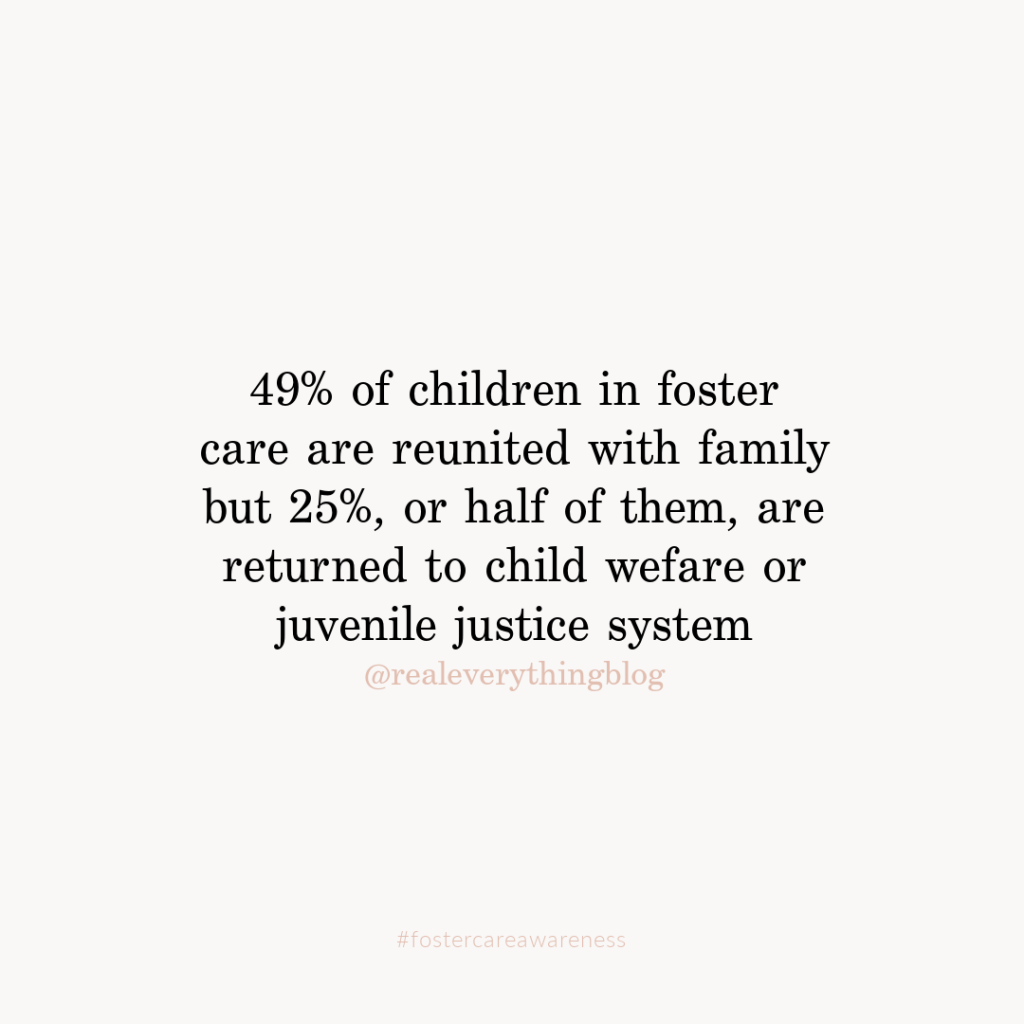
Returning into the System
When we look at those who re-enter the child welfare system, either as returning to the child welfare system or moving into the juvenile justice system after reunification from foster care, the rate of re-entry is 25% (in a study of 2259 children). Regression analyses further suggested that many of the risk and protective factors associated with standard child welfare reentry were also predictive of multi-system re-entry such as having previous child welfare experience and child behavior as a factor at removal. Findings of this study support the need to focus research efforts on understanding effective practices within child serving systems so that re-entry into either system is mitigated. [source]
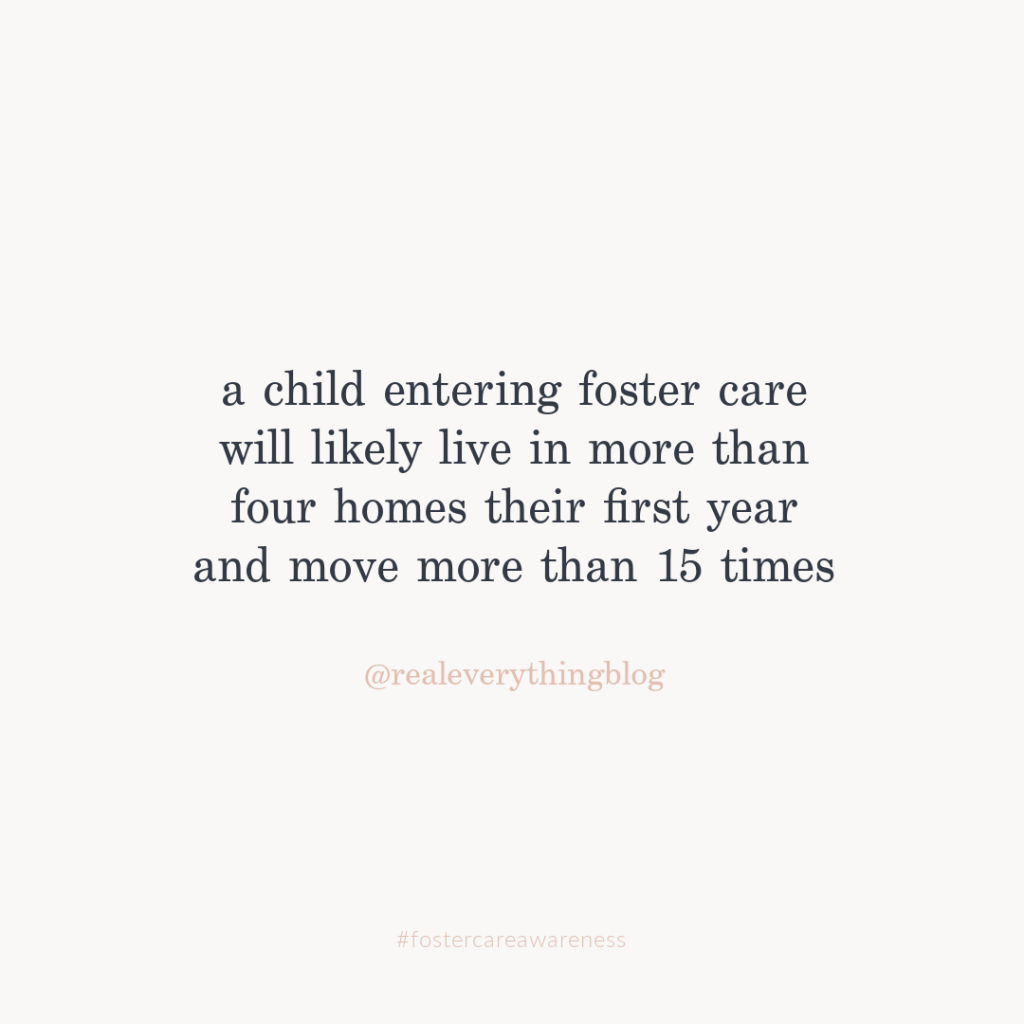
A child entering foster care will likely live in more than four homes during the first year of care. It is common for children who grow up in foster care to move more than 15 times. Each move can mean falling further behind in school and having to make new friends.
Institutions
Even before Covid I was shocked to learn that foster kids in my state are often placed in Juvenile detention centers because they have no place else to go. Having committed no crime at all, but of course this often puts those kids on a path they would otherwise have been able to avoid in a safe, stable environment at home.
…his only crime was being a foster child in an era when a surging number of biological parents are falling into the grips of drug addiction and child welfare systems are struggling with a shortage of foster parents. In hasty attempts to address the problem, case workers and courts have been funneling children into crowded emergency shelters, hotels, out-of-state institutions and youth prisons — cold, isolating and often dangerous facilities not built to house innocent children for years [source].
Hierarchy of Needs
No discussions of health and wellness exist if basic fundamental needs are not met. Without shelter, food, and safety, a child cannot possibly worry about their math homework or vegetable consumption.

Maslow’s hierarchy of needs, a scalable vector illustration on white background
How We are Failing these Kids
Where the parents are unable or unwilling to meet the goals, they may choose to terminate parental rights or the state can argue in court to terminate them legally. Teenaged children also have significant input in that decision. The state tries to support parents as much as possible to reunify – with addiction treatment, therapeutic services for abuse, and helping them get financial support if neglect is from lack of means. The problem is, budgets limit the impact the state has.
That means that families and children are often without the support we know kids need to succeed. Especially after reunification – we can see from the statistics that families demonstrate they are doing better with state support. But when we abandon them after kids leave care, they may fail to achieve success.
If we focus on supporting the system itself, with lower case loads for workers, and maintaining a treatment team as part of “wrap around services” after reunification, we will see a reduction on the long-term harm to children and less issues as they grow up.
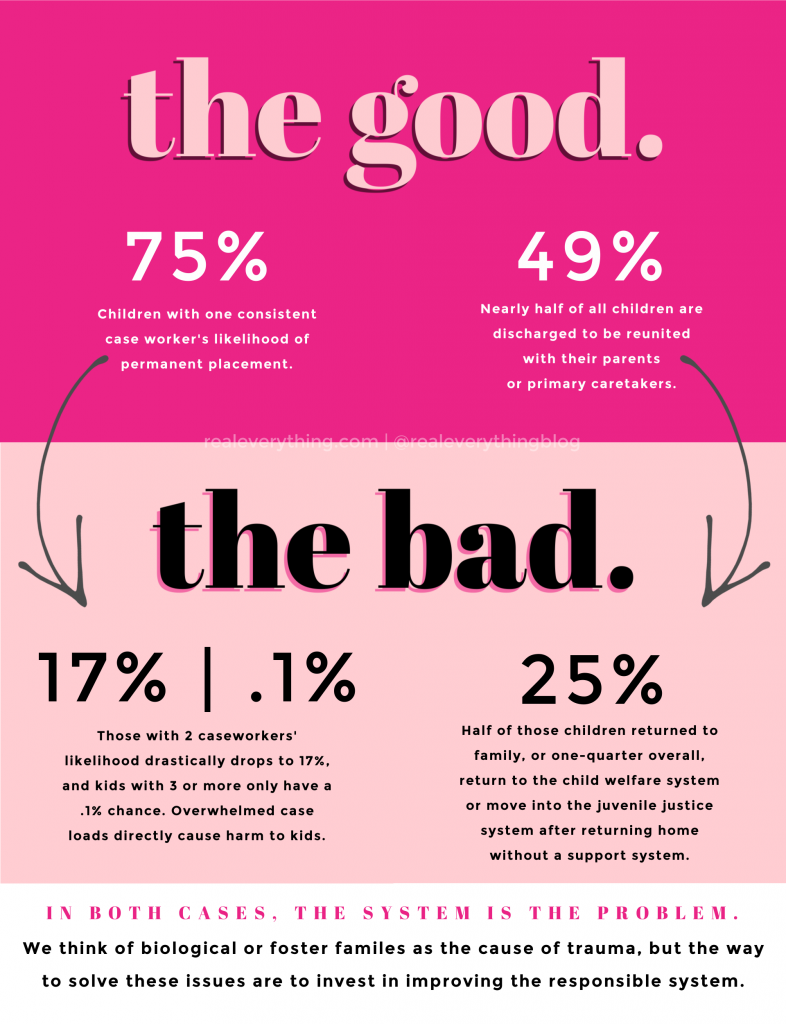
The Team
In an ideal scenario, a foster family has a team supporting their success. From bio family to kiddo and foster family, all have resources dedicated to support everyone’s well being:
- CASA – volunteer position, perfect for people who want to be involved and help; advocates for what the child wants
- GAL – legal advisor to judge about what kiddo wants
- Lawyer – kiddo and bio fam each have their own court-appointed lawyers
- DSS worker – legal guardian for kiddo when in care (signs school forms, etc.)
- Treatment providers – my kiddos have had many: wrap around services (to try to prevent foster care), intensive in-home therapeutic services, therapy (for both kid, bio parent, and family together)
- I also have a ‘therapeutic foster care worker’ and their team of supervisors who supports me, a foster resource parent and family
- Medical professionals and doctors for med management, etc.
Problems with the Team
What we know: caseloads of social workers has a direct impact. Children with one consistent case worker have a 75% of permanent placement. Those with 2 drop drastically to 17%, and those with 3 or more have a .1% chance of being placed. source
For example, our kiddo is still working with a lot of professionals in the county where they’re from, rather than switching, because of wait lists. It takes a lot of privilege for me to have the time and resources to drive an hour one-way for multiple appointments, not all foster parents have that ability – which would reduce the access a foster child would have.
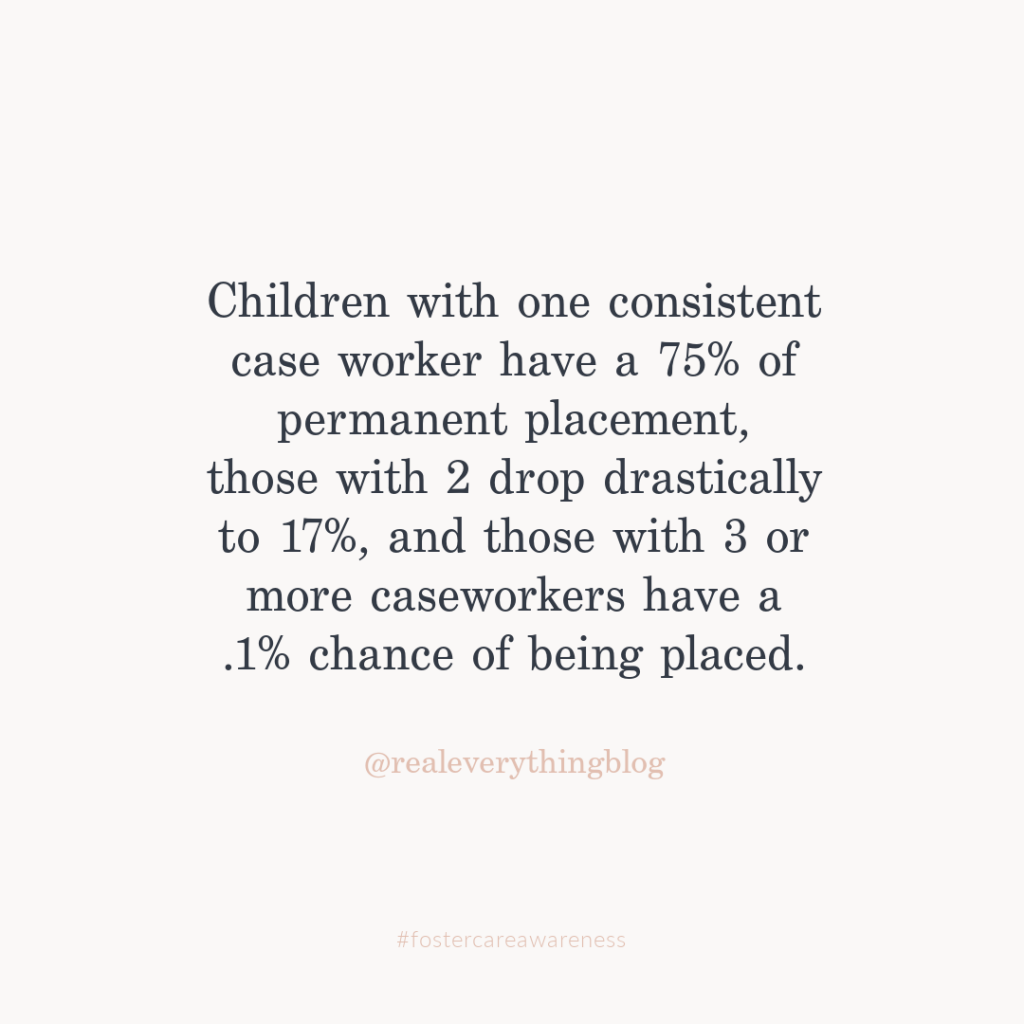
Systemic Issues
My experience has been that, while it’s a huge list for administrative paperwork and appointments, kiddo and bio fam have tremendous support. Of course there are tons of things I wish went differently, but I genuinely see kids best interest as the goal. see two recent issues as significant to the health and wellness of kids in care:
- Covid has had a significant impact, and
- Our system cannot provide because the system lacks the resources to adequately provide safety for many.
Take your pick of the numerous articles written on this:
Group homes are often not the answer in normal circumstances. Many of these facilities are rife with physical and sexual abuse, and now they’re breeding grounds for COVID, as well. And when you do try to separate kids for social distancing, it can feel to the kid like isolation and abandonment, which compounds their trauma. [source]
Ma’Khia Bryant
I have significant privileges because I live in an area with funding for all these roles and programs. The story of Ma’Khia Bryant really affected me. It felt like a member of my community was wronged by the system that was supposed to protect her. If her treatment team has been more involved and available, if she’d had the opportunity to build trust with regular interaction, she could still be alive today – as she would have called her social worker instead of the police.
“I want to leave this foster home,” she tells the dispatcher. “I want to leave this foster home.”
Twenty-three days later, Ja’Niah called 911 again, telling the police that she and her older sister were being threatened by two young women who used to live at the house. Officers arrived in the middle of a melee outside the house, and one of them fatally shot Ja’Niah’s 16-year-old sister, Ma’Khia Bryant. [source]Bryant’s grandmother, Jeanene Hammonds, said Ma’Khia called her that afternoon asking for help. She told her grandmother that there was trouble at the foster home involving a former foster child who had previously lived at the residence. The young woman had returned for a visit and was upset over the condition of the house, sparking an argument, Hammonds said… the disturbance at the house and Bryant’s death also are indicative of deeper problems in the state’s foster care system, said foster parents and child welfare advocates, many of whom are now calling for reforms to the overwhelmed and disjointed system caring for abused and vulnerable children. [source]
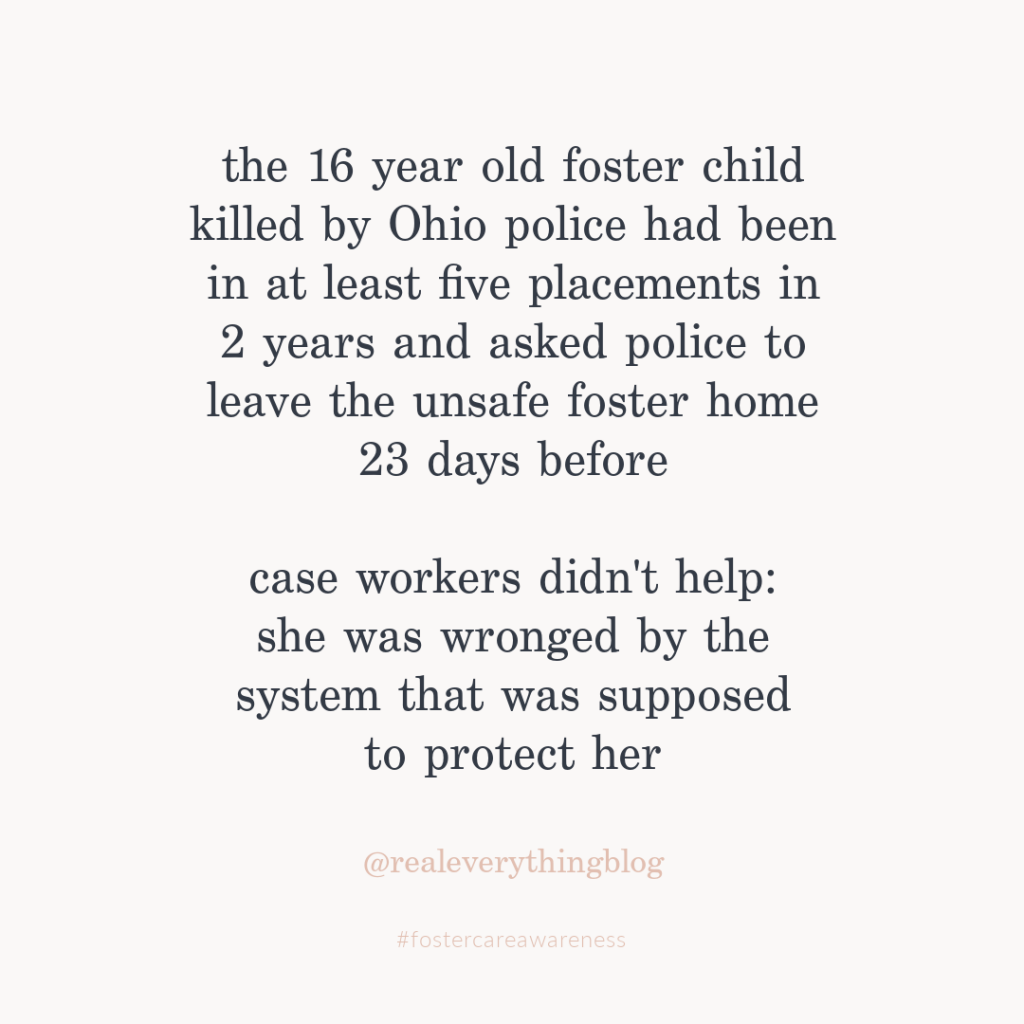
Systemic Racism Child Welfare
And then we add in systemic racism…
Black children, like Ma’Khia and her sister, account for nearly a third of children removed from homes — nearly twice their proportion in the population.
A shocking study found that 53% of Black children in the U.S. will be investigated as potential victims of child abuse by age 18, 16% higher than the rate for all children — even though studies show no relationship between race and child maltreatment. Once in the system, Black children also more often languish in foster care, more often fail to reunify with their families, more likely to receive placement in group care, age out in greater numbers, and become involved in the criminal justice system.
The pipeline that feeds youth in foster care and juvenile justice facilities into the adult criminal system is especially harmful. As of 2015, Black youth were five times as likely as white youth to be detained or committed to juvenile justice facilities. Black children face separation from their families and placed in foster care at a far higher rate than white children, often repeatedly. They are also more likely to be placed in a group home where they face additional trauma and abuse.
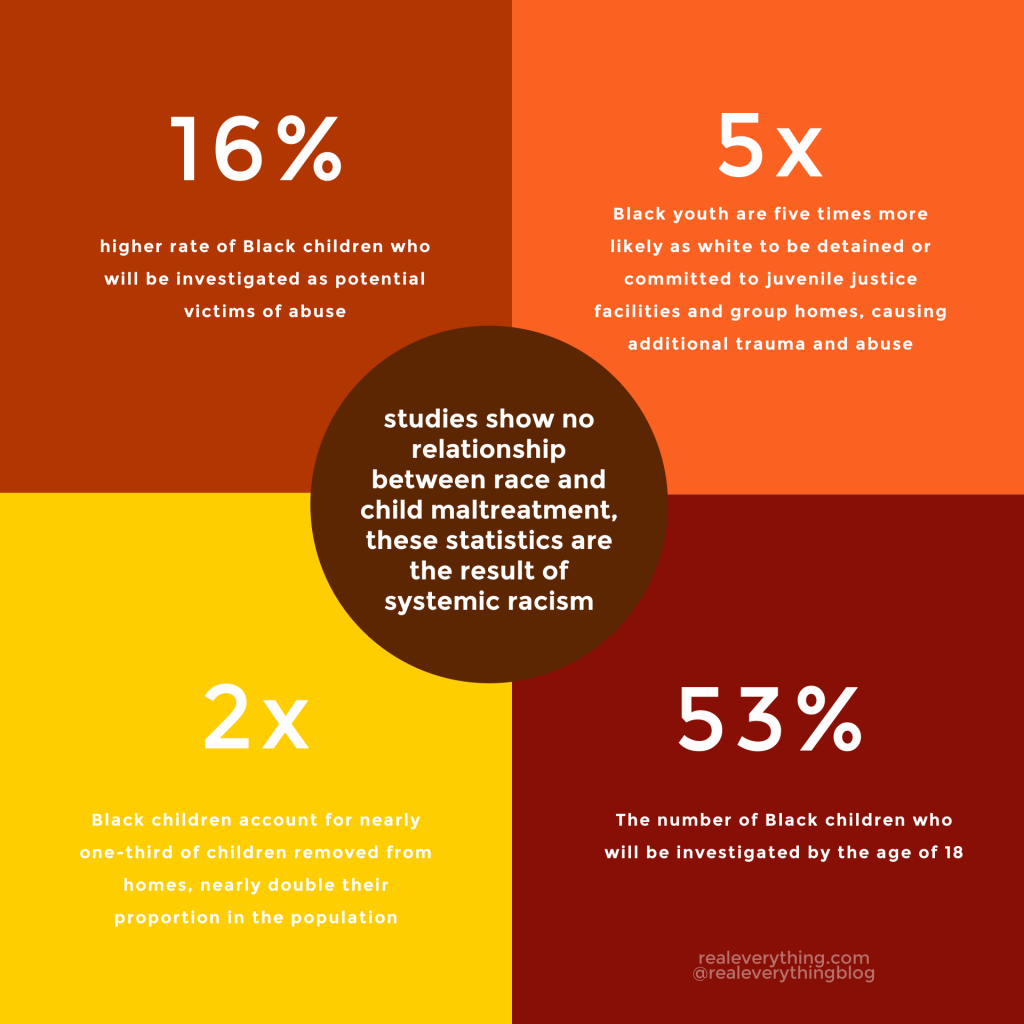
Cornelius Frederick
In a devastating tragedy one year ago, staff members restrained and killed a 16-year old Black boy, Cornelius Frederick, while being held in a for-profit foster care group home facility. Before he passed out from the restraint hold, Cornelius is reported to have yelled “I can’t breathe.” [source]
A survey conducted in April by the Justice Collaborative institute showed a strong bipartisan majority of voting Americans support for stepping up to protect kids. We must do more to protect children like Cornelius from abuse and neglect — and now is not the time to pause. We must demand that the health and safety of our children are prioritized. And we will continue to fight to reduce the population of detained youth and return them to their families and family settings. It is the best solution we have for keeping them healthy and giving them the chance to heal from the mental anguish they have suffered.
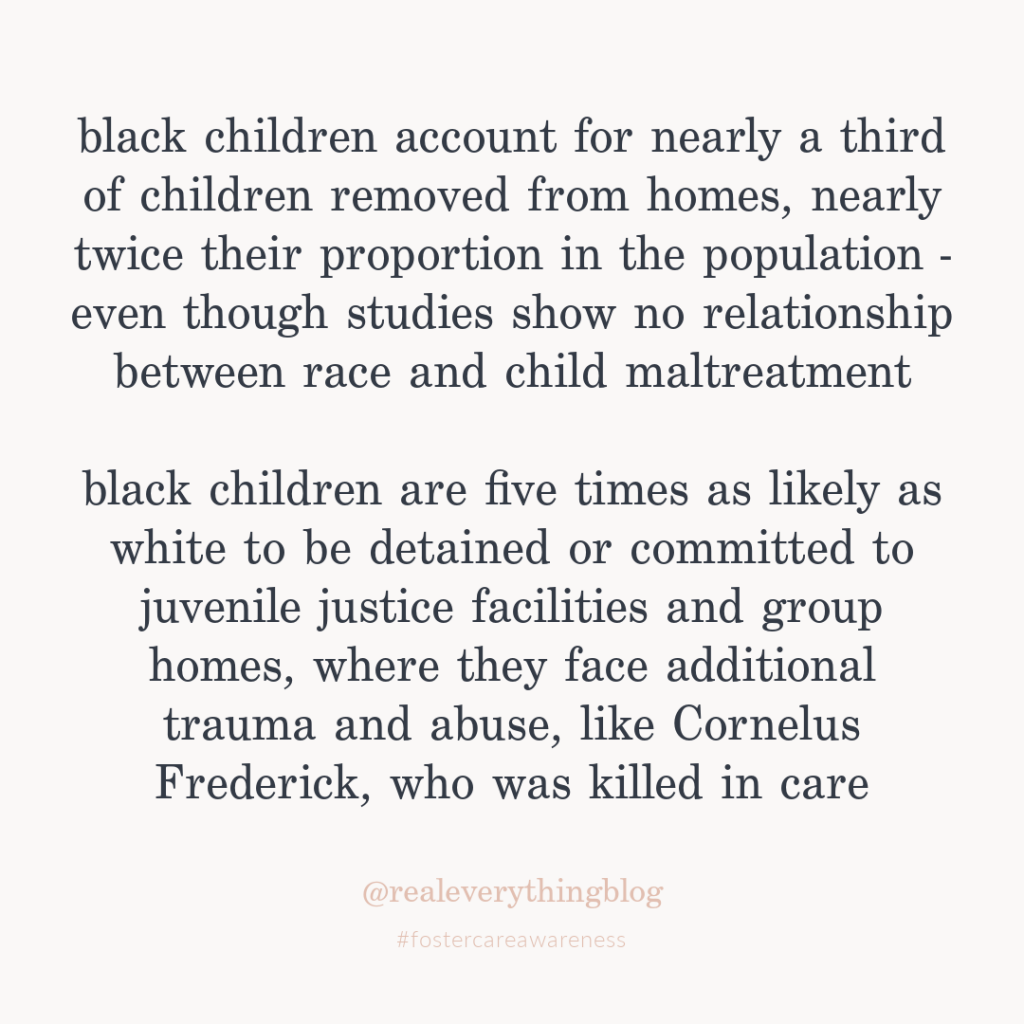
The percentage of Black or African American children in care on September 30 decreased between FY 2008 and FY 2018. While the percentages of White children, Hispanic children, and children of other races or multiracial children increased. [source]
Trauma Compounds
As much as the intent is positive for children – entering care in and of itself is traumatic. Then for those who move multiple houses or are in for years, working with endless team members whom they build trust with and then leave, it feels like abandonment, over, and over.
Children and adolescents with foster care experience are diagnosed with PTSD at twice the rate of US war veterans. Thus, we need to focus our treatment and their care from a trauma-informed perspective. Yet, despite knowing this, we do not have a functioning system or process to support the necessary services. Not only for these children who reunify with families but also those who age out of the system.
In 2010, the Tufts Clinical and Translational Science Institute estimated that the rate of psychotropic medication use for youth in foster care is anywhere from 13 to 52 percent, compared to about 4 percent for youth in the general population. And a 2014 Government Accountability Office (GAO) report found that at least 18 percent of children in foster care were taking at least one psychotropic medication. Some of the medications have not achieved approval as safe and effective for children by the FDA. [source]
The Cost of a Broken System
Within four years of aging out:
- 70% will be on government assistance
- about half will not complete high school
- only 3% of youth in foster care graduate from college
- 50% have no earnings (and those who do make an average annual income of $7,500)
- 25% face incarceration within 2 years
Not only is this a tragic loss of potential, but our economy as a whole suffers a cost of $1 million per youth we fail because of lost production and the cost of social services. After a foster youth ages out, homelessness and unemployment become a huge issue. This is linked to increased risk of drug addiction, unwanted pregnancy and trafficking.
Trafficking
This statistic is one that keeps me up at night. If 1% of foster kids run away, that’s 4k/year at risk of being trafficked. Children are particularly vulnerable to exploitation, especially those connected to the child welfare system.
- In the U.S., 60 percent of domestic child trafficking victims have a history in the child welfare system.
- Traffickers target youth in foster care because of their increased vulnerability due to a lack of family and emotional relationships and support.
- 74% of child trafficking cases involved sex trafficking, and the majority of those involved pimp-controlled prostitution.
- The average age of child sex trafficking victims is 15, according to numbers of children reported missing [source]
The overwhelming majority of missing children reported are endangered runaways. The statistics tell us that last year:
- 91 percent of kids reported missing were children running away from home or foster care.
- The second highest rates of missing children were abducted by a family member who did not have custody.
- Less than one percent were non-family (stranger) abductions. [source]
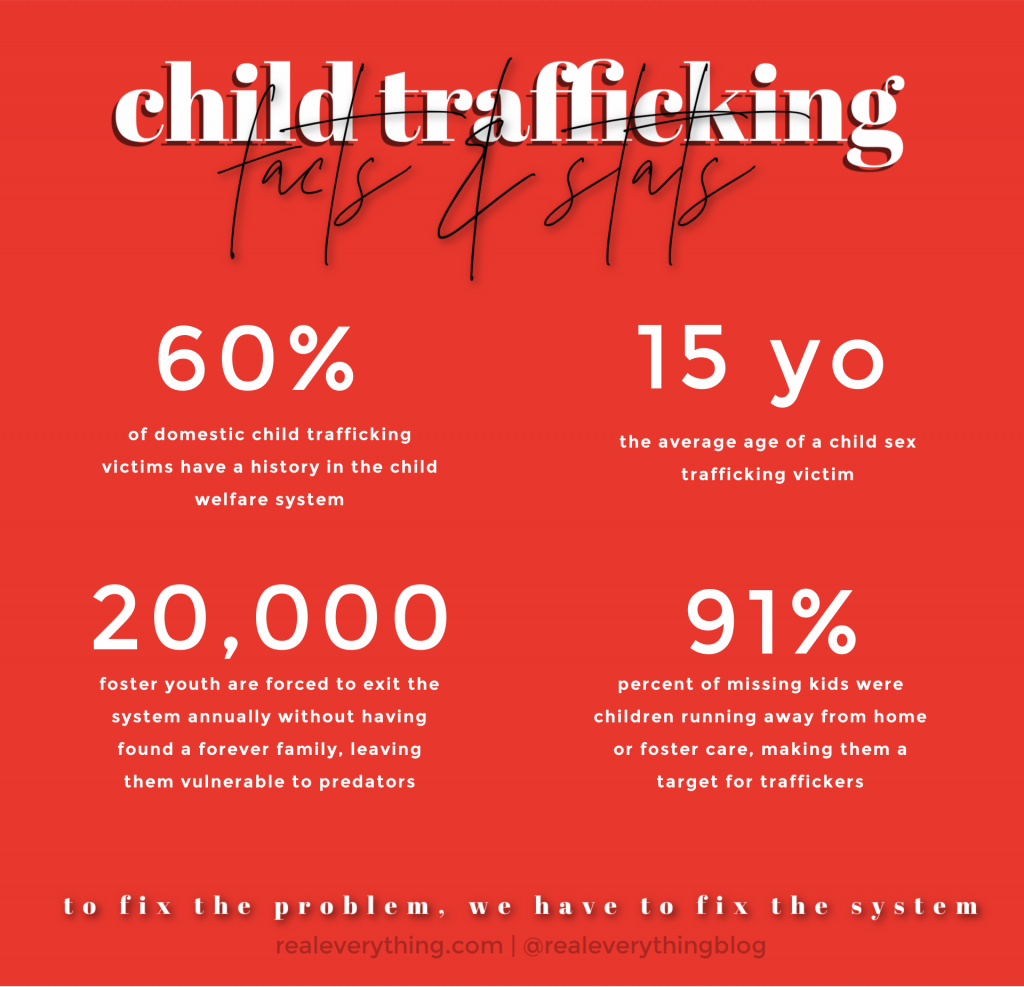 More info: Child Sex Trafficking
More info: Child Sex Trafficking
While the average foster kid age is about 7 yo, roughly 20,000 youth are forced to exit the system annually without having found a forever family. This leaves them to fend for themselves. Imagine how different those numbers would be with properly staffed programs for DSS workers to check-in follow kids to ensure stability. Foster families can also cause harm; because there is less oversight from an overwhelmed system, children suffer. This is where we see children taking risks to live on their own. Additional abuse in a foster home is a failure on the system set-up to protect them.
LGBTQ+ Foster Kids
- A 2019 study found 30.4 percent of youth in foster care identify as LGBTQ and 5 percent as transgender, compared to 11.2 percent and 1.17 percent of youth not in foster care.
- The Williams Institute also found that around 40 percent of homeless youth identify as LGBTQ
- LGBTQ homeless youth are roughly 7.4 times more likely to suffer acts of sexual violence than heterosexual homeless youth with kids who have been in foster care.
- They are 6x more likely to experience anxiety, and
- and 8x more likely to experience suicidal ideations (source)
Without safe foster care placements, and without the vital support of caseworkers and other child welfare professionals, LGBTQ youth often flee abuse in foster care only to face homelessness and sexual exploitation.
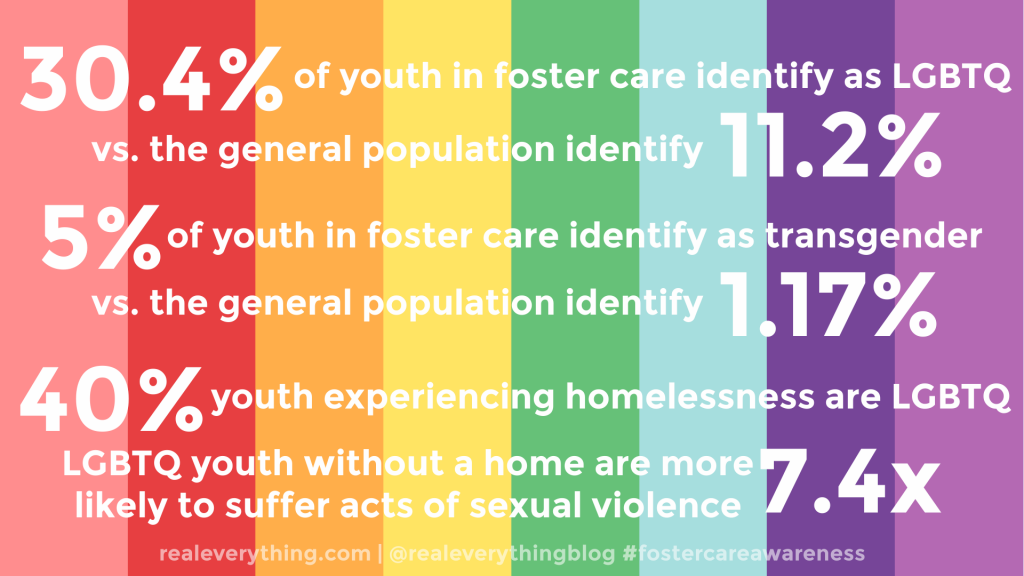
What Can We Do?
- Volunteer as a:
- Become a foster parent.
- Provide respite (like babysitting for foster kiddos to give foster families a break).
- Become a CASA.
- Provide resources for agencies and families, like donations, meals, help recruiting, or administrative support.
- Continue to talk openly and honestly about what foster care is – and isn’t. There are so many misconceptions from TV and film, that people often assume the worst.
- Donate – time, money, or goods:
- Donate a “birthday box” through Together We Rise, a non-profit organization that will ensure a kid with the same birthday gets a pre-packaged birthday box to their social worker.
- Support kiddos aging out of foster care through the Dreammaker’s Project Shop, where kiddo creations are available for you to purchase. I personally have bought the spices and artwork cards!
- Sponsor kids aging out who have basic needs to survive, at Dreammaker’s Project – like bus money to get to their job, or money for a computer to finish school.
- Donate goods (like suitcases and car seats) caseworkers and agencies may need.
- Donate or sign-up for a children’s rights membership.
- You can support my specific Agency, UMFS, or find one in your local area.
You can shop Beautycounter with me – this month I’ll be donating 20% of all my proceeds to these organizations. Last month I was able to raise $2500 for Children’s Rights, who fights for systemic change. $1 donated is equal to $100 into the system because of the broad impact they’ve been able to make.
Want more info on our Real Life? Never miss a post with our Real Everything newsletter. Get our best selling book, Eat Like a Dinosaur, as a welcome gift as well. Join here!
Wanna be Healthy Inside & Out? Get educational info and exclusive sales with our non-toxic living newsletter. Get free samples as a thank you for joining our safer skincare community as well. Join here!
If you feel inspired by this post, please share it!

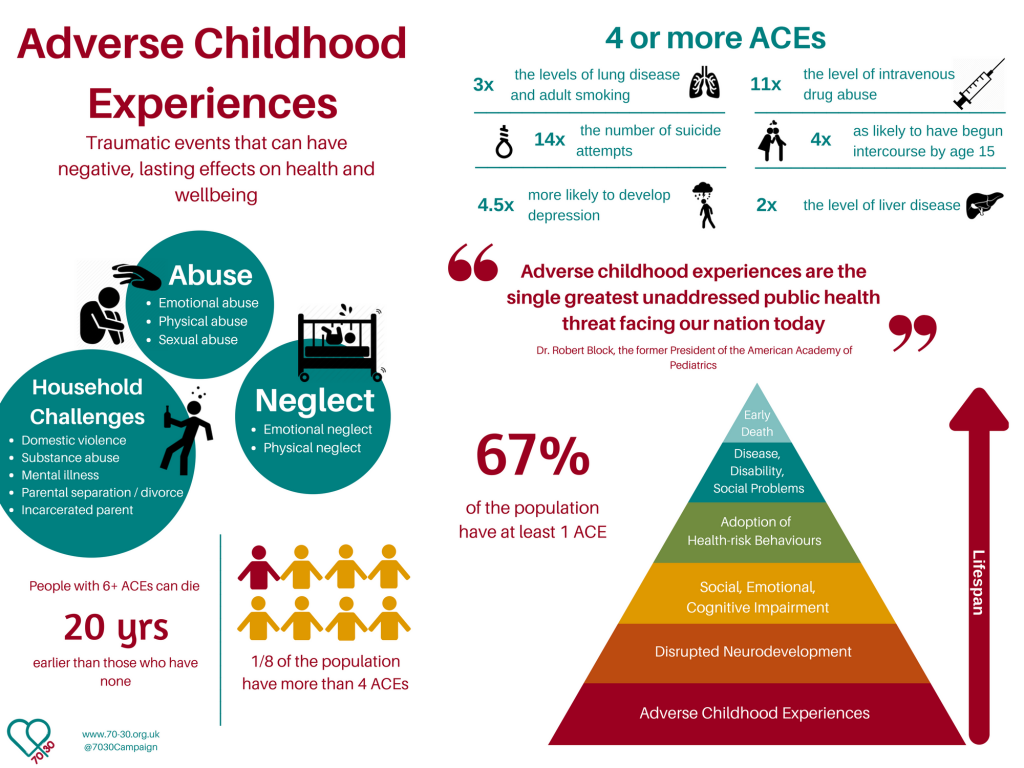
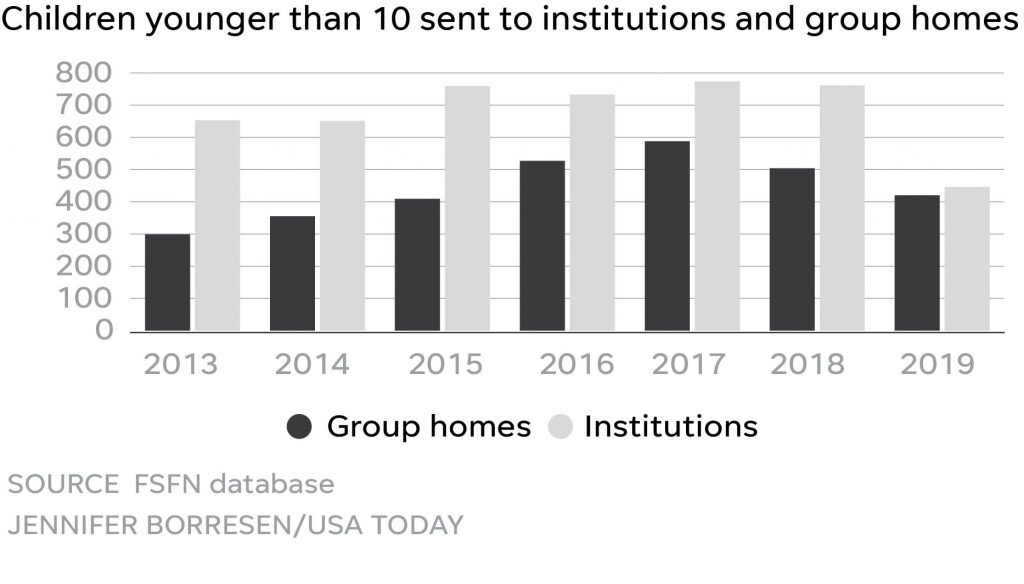
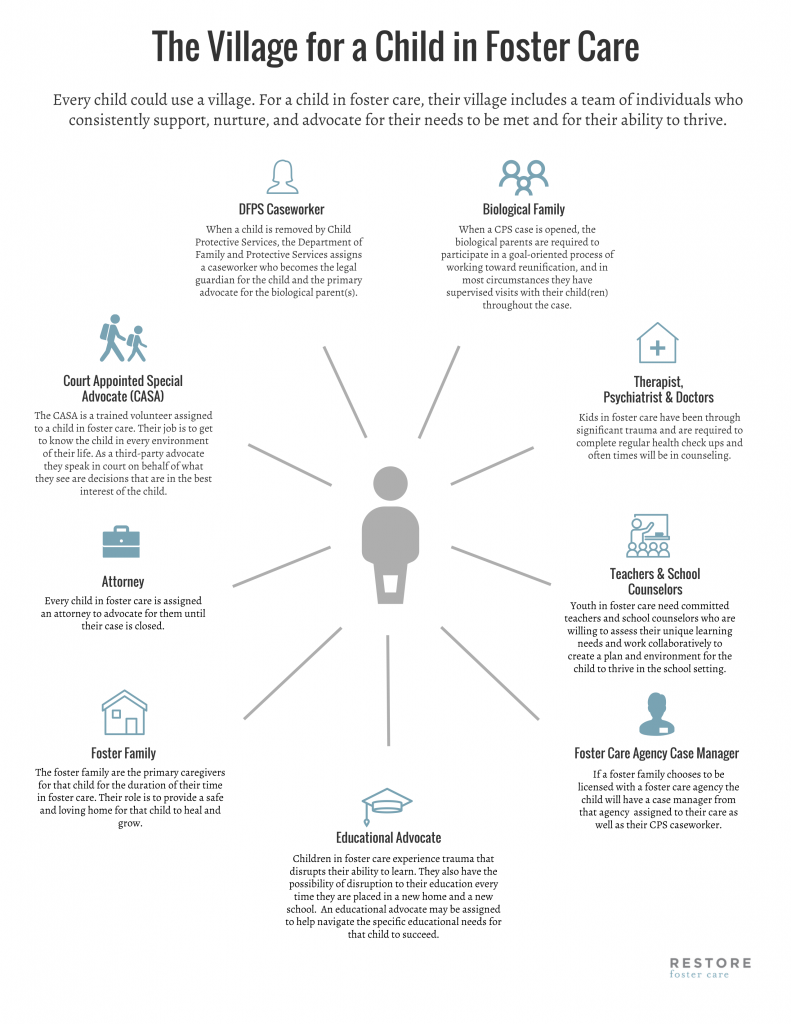 source: Restore Strategies
source: Restore Strategies